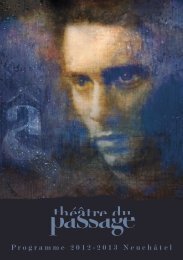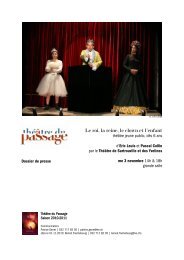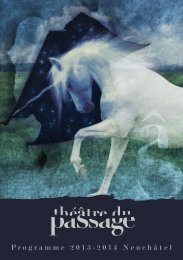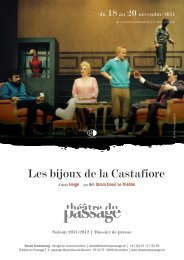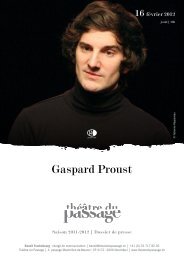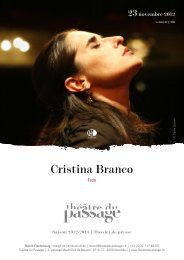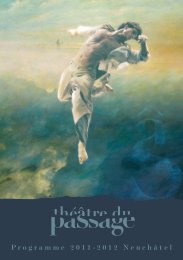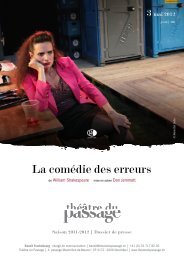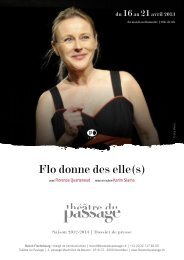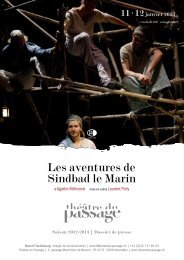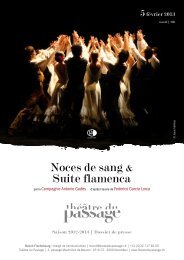BIOGRAPHIE COLLABORATEURS - Théâtre du Passage
BIOGRAPHIE COLLABORATEURS - Théâtre du Passage
BIOGRAPHIE COLLABORATEURS - Théâtre du Passage
Create successful ePaper yourself
Turn your PDF publications into a flip-book with our unique Google optimized e-Paper software.
NEW WORKThe work is a contemporary reanalysis of Purcell‘s Dido and Aeneas and Gluck‘s Orpheus. I will explainhow these two unrelated works interact later in this proposal. To begin, however, I want to give the reasonswhy I‘m interested in working with Baroque. Baroque musical structures tend to lend themselves well tocontemporary dance <strong>du</strong>e to their inherent coldness and musical construction. These defined rhythms offerpoints to which contemporary choreography can attach itself, while avoiding period emotionality, andmannerisms, which would be irrelevant in today's aesthetics.The inherent coldness of Baroque structures permits precise choreography to coexist with precisecomposition, encouraging the choreography to observe the theme from a "detached" point of view.Purcell‘s Dido and Aeneas and Gluck‘s Orpheus and Eurydice are, of course, master works that representhigh points in Baroque opera. I recently finished a collaboration with the British composer Gavin Bryarson the deconstruction of Tchaikovsky's Swan Lake and Sleeping Beauty. In the New Work, I observe andrestate these operas by Purcell and Gluck.Narrative in ballet can be dangerous because it often comes at the expense of burdening thechoreography with a story line and potentially simplifying its structure. The New Work is my attempt to seewhether story telling and movement structures can be independent of one another. A counter-intuitiveproposition, but one that I feel has merit. Can the choreographic structure remain independent from thenarrative it carries? In other words, can choreographic complexity coexist with clarity of theme?In addition, can purely narrative structures (acting, story telling, etc.) exist on stage at the same time asabstract dance structures, to the mutual reinforcement of both?Can decor advance the story separately from the dance so as to shape the meaning of the dance like alens shapes light? Can film also be used on stage in order to advance narrative to an extent not desirableusing choreography alone? These are questions that interest me.THE REFERENCEThe piece begins with Dido and Aeneas. As Dido dies, the ballet immediately leads into Orpheus andEurydice. It moves from Dido‘s death to Eurydice‘s isolation in Hades waiting for the arrival of Orpheus. Inmy opinion these two works, though unrelated, will, because of their chronological proximity, encouragethe audience to link them structurally and perceptually. The audience will essentially invent a new storymade up of two older and separate ones.This is because, in my opinion, observation is by nature inclusive. An audience will always put thingstogether regardless of whether they are in fact related to each other. Much like we put tree and windtogether or sun and moon or ground and sky. In my opinion as soon as we see something it stops beingpart of a subjective reality and becomes a symbol. Symbols have properties that are fluid and cantherefore be distorted to fit our own realities.This is of particular interest to me because I think that cultural memory functions in just such a way.Events over time are often bent and distorted to form new variations.




